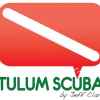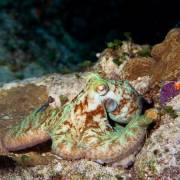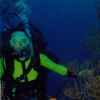Dive in Mexico
-
Cañonero Chairel Isla Mujeres, Mexico
Strong drift, located about 25 minutes away when going by boat. A great dive inside this navy boat, explore the bathrooms, the office, passing by the guns. You will see schools of barracudas and snappers. -
Snorkeling with whale sharks Holbox Island, Mexico
Swim up close in the natural environment of the Gulf Of Mexico with the Ocean's largest sish: The "whale sharks". These huge sea creatures are found off the coast of Holbox Island Mexico in the state of Quintana Roo near Cancún.The whale sharks are harmless & Non Threatening to humans. In… -
The Garden Banco Chinchorro, Mexico
has excellent soft corals and sponges in the shallower areas and another patch reef in 60-80 feet of water -
Aquarium I & II Banco Chinchorro, Mexico
Aquarium I and Aquarium II, just south of Cayo Centro, are 16 meter anchor dives amid an abundance of sea fans and elkhorn coral. The sites frequently have large schools of blue tang. -
Dos Primas Banco Chinchorro, Mexico
DOS Primas, a 30-35 meter drift dive site between Cayo Centro and Cayo Norte, features immense sponges, large-sized black coral trees, and, frequently, large grouper. -
The Cut Banco Chinchorro, Mexico
The Cut is an 25 meter foot dive near the cut to Cayo Centro. It's located along a sloping wall that drops from 13 meter to 35 meter and is covered with antler corals, black corals, and gorgonians. This is a fishy site among big coral heads and canyons that has no significant current. -
Punta Isabel Banco Chinchorro, Mexico
Punta Isabel is located in front of Cayo Centro. It's an 25-30 meter drift or anchor dive among large sponges, gorgonians, and corals. There are often snapper, grouper, and barracuda as well as sea turtles, eagle rays, lobsters, and conch -
Paradise Banco Chinchorro, Mexico
Paradise is a shallow dive in about 13-16 meter of water in front of Cayo Centro. This anchor dive has a lot of elkhorn and brain corals, and usually plenty of blue tang, hogfish, and pink conch. -
Kai Ha Banco Chinchorro, Mexico
Kai Ha is a 35-60 foot dive just north of Punta Gonzalez that tends to be a very fishy site. -
Punta Gonzalez Banco Chinchorro, Mexico
Punta Gonzalez is a 13-30 meter drift dive with immense sponges, many large gorgonians, and usually a chance to see sea turtles, eagle rays, and lobsters. It is located in front of Cayo Centro. -
La Boya Banco Chinchorro, Mexico
La Boya is a great dive site with a flat sandy top at 10 metres, then a sloping reef wall with hard and soft corals that gives way at depth to another sand flat with some really enormous barrel sponges, yellow tube sponges and elephant ear sponges that must be about 3 metres across! Careful scrutiny… -
The Chinchorro Reef Wrecks Banco Chinchorro, Mexico
The Chinchorro Reef was known to sailors who dreaded it as early as the colonial period. Traveling from Cartagena, Colombia, to Spain by way of Havana, Cuba required ships to pass close to the bank. The winds and currents of the region worked against them, and many vessels went down at the reef. The… -
Unidentified Galleon Banco Chinchorro, Mexico
This wreck site contains a cargo of silver bars from Peru. -
Spanish Galleon Anchors Banco Chinchorro, Mexico
17th century ship containing 2 anchors and a large quantity of river stones that were used for ballast. -
SS Far Star Banco Chinchorro, Mexico
Far Star was a 1970s cargo boat laid down in 8 meter of water. A large steel-hulled transport ship, it was loaded with sugar when it ran aground on the southeast corner of Chinchorro. Starting just beneath the surface, the spur and groove reef structure is littered with a profusion of steel plating,… -
Pecio Ingles Banco Chinchorro, Mexico
Built around the 16th century. A canon, anchor, and money can be found. -
Kassel Banco Chinchorro, Mexico
German ship constructed in the 20th century out of steel. Ran aground in 1955.v -
SS Glen View Banco Chinchorro, Mexico
The Liberian Steamship Glenview ran aground on Banco Chinchorro off Yucatan, Mexico in latitude 18 degr. 37' N - longitude 87 degr. 15' W on January 24th 1964. While on ballast voyage from Puerto Barrios, Guatamala to Tampico, Mexico. The salvage tug 'Cable' reached the wrecked vessel 5 days later… -
SS Ginger Screw Banco Chinchorro, Mexico
Shrimp boat from the 20th century. The original name is Inger Shoal. -
Cuarenta Canones (40 Cannons) Banco Chinchorro, Mexico
The shallow bottom near Cayo Norte is littered with scores of brass cannon, some over ten feet in length. Dating to the 17th century, experts say these cannon suggest that this may be a Dutch wreck, or possibly even a pirate ship. There is also at least one very large cast-iron double-fluke anchor.… -
Copper Clad Wreck Banco Chinchorro, Mexico
Lying in 70 feet of water, what remains of the wreck are only the traces of the hull timbers, brass nails, and hand-hammered copper sheeting that once clad the hull to protect it against invasion by marine worms. This unusual cladding indicates that this wreck dates to the 18th century. The wooden… -
La Chimenea Xcalak, Mexico
- -
La Catedral Xcalak, Mexico
You will drop down the wall to 60 feet, then swim along the face until you reach the opening to “La Catedral”. This is a huge cavern that has a large debris stone in the center. You can also dive along this beautiful coral wall.Huge tarpon, barracuda, and schools of silver sides dance in the… -
Alejandro's Reef Xcalak, Mexico
- -
Santa Julia Xcalak, Mexico
- -
Doña Nica Xcalak, Mexico
This site has 2 distinct coral formations-a shallow wall from 30-50 feet facing sand flats. This is a favorite site for instructions as the depths are shallow, it has soft sand for doing training exercises, and lots of marine life. We also use it for night dives due to large numbers of lobster and… -
Hob Na (Grouper Hangout) Xcalak, Mexico
- -
Cenote Azul Xcalak, Mexico
In the unlikely event that the sea is too rough to dive Xcalak, dive centers offer a two tank trips to Cenote Azul and Bacalar, the Lake of Seven Colors.Cenote Azul is the largest pit cenote in Mexico, 600 feet across and 290+ feet at the center. The diving here is the most bizarre and thrilling… -
Dos Ojos Mahahual, Mexico
This site is located south of fishermen dock. It is known as 'Dos ojos' (Two eyes) because it is broken in two big sandy areas. This place is very shallow water being special for Discover Scuba Diving, beginners, second dives or nigth dives. -
Gonzalo'z Reef Akumal, Mexico
This site is decorated by large, vivid reef fingers. You are guaranteed to see Hawksbill, Green, and Loggerhead turtles here feeding, playing, and checking out the visiting divers. -
Puentes Puerto Morelos, Mexico
The reef Puentes is a a 20m/ 60ft dive with natural bridges and swim throughs where you can find reef life and larger fish. -
The Gardens Puerto Morelos, Mexico
The Gardens is a 17m/ 45ft dive which allows you to swim through the beautiful, colorful coral reef while seeing multitudes of different sizes and colors of fish. -
Bull Shark Dive Playa Del Carmen, Mexico
Bull Shark Dives usually take place in the afternoon from November to February.Although Bull sharks grow slowly, their average size is about 400cm/12ft to 650cm/19ft and they reach a maximum total length of probably 800cm/24ft. It feeds on fishes, other sharks, turtles, birds, invertebrates and even… -
Laberinth Acapulco, Mexico
This dive site is only accessable during the calm season from about October - May and has some mystics and great canyons. You get easy lost if you don't stuck on your guide. The dive site can be accessable a part for beginners and a part only for certified divers. Of course on the surface all… -
La Cagada Acapulco, Mexico
One of the best Dive spots. Diving around the rocks to shallow water like "El Jardin" or further depending on the air consumption. This dive site is strongely recommended for diver with experience. Surface and underwater current can be expected during the dive. Different kind of School fishes and… -
El Jardin Acapulco, Mexico
Beautiful Dive Garden with a huge kind of different fishes, like different type of Ballonfish, Scorpionfish, Stingrays, Boxfish, Murays, Starfish, Turtles, Barberfish, Sergan Major fish, Blenny's, Surgeonfish and Eagle Ray's -
Bufadero Acapulco, Mexico
"Bufadero" is a beatiful dive location with huge rocks and different kind of fishes. The current can be very strong sometimes (vertical current). This dive site is only for Advanced Certified divers with experience in drift and current dives. -
Solitary Rock / Piedra… Ixtapa-Zihuatanejo, Mexico
It is a circular route around the rock can be under taken at varios depths and will always allow you to experience a huge variety of sea life. Large rock formations, and abundance of algae and different species of fish swimming in shoals make it a special dive site.The Solitary Rock is found at only… -
Los Morros de Potosi Ixtapa-Zihuatanejo, Mexico
Los Morros de Potosi is one of the most fascinating diving areas of the Mexican Pacific. There are three large white granite rocks emerging from the water and their whiteness has given them the name "los Frailes Blancos". There's a perfect equilibrium of marine fauna and a great variety of birds… -
El Chimo Puerto Vallarta, Mexico
Chimo is a small fishing village located south of the bay. The above water views of the tropical rain forest are breathtaking. This area is better enjoyed by divers with some level of experience. The rock formations and corals are impressive. Giant mantas are often seen here. Huge schools of fish…




